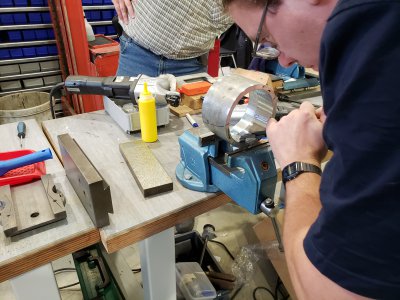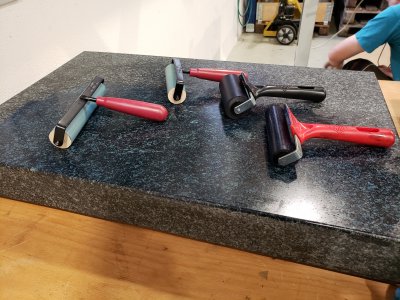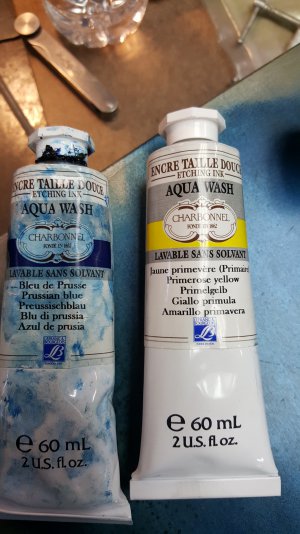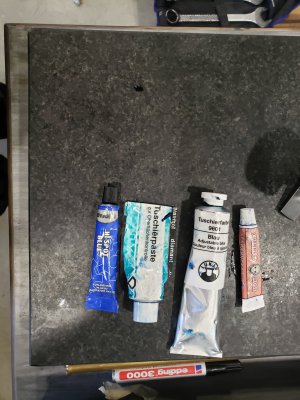-
Welcome back Guest! Did you know you can mentor other members here at H-M? If not, please check out our Relaunch of Hobby Machinist Mentoring Program!
You are using an out of date browser. It may not display this or other websites correctly.
You should upgrade or use an alternative browser.
You should upgrade or use an alternative browser.
Surface plate marking compound
- Thread starter redvan22
- Start date
- Joined
- Nov 27, 2012
- Messages
- 7,852
Prussian blue is actually a pigment but the stuff I'm talking about is commonly used in automotive as a gear marking compound to set gear lash. There is also a yellow marking compound available for this use. The marking compound doesn't dry & is used in the case talked about here also.
But yes, some people use oil based paint pigment as an alternative. Doesn't dry as fast as paint normally would but it still does. Should be able to find the Permatex Prussian Blue at any auto parts store although I have heard that these days some stores don't carry it anymore.
But yes, some people use oil based paint pigment as an alternative. Doesn't dry as fast as paint normally would but it still does. Should be able to find the Permatex Prussian Blue at any auto parts store although I have heard that these days some stores don't carry it anymore.
- Joined
- Feb 1, 2018
- Messages
- 1,868
Look at DAPRA.com under Scraper accessories and they sell a product that is water soluble they sell blue and yellow that washes off really good. they sell soft rollers too. I like soft to spread and hard "Brayer" on Amazon or at art stores. Dapra also sells a oil based that stains hands called Diament and you can also but Dykem High Spot blue. Diament and Dykem stain fingers and clothes. I never have been a fan of Permatex as it smears really easy. Recently we have tried Charbonel Prussian blue. It is sold at art supply stores. Also I tested Walmart arts and crafts acrylic paint and surprisingly it worked good for the highlighter and blue.. Mike I am a Professioanl rebuilder and I would be happy to walk, write and talk you through rescraping your crossslide.
Attachments
Last edited:
- Joined
- Jul 2, 2014
- Messages
- 7,594
Not the cheapest, but the best I have used...
- Joined
- Feb 1, 2018
- Messages
- 1,868
I like the Chabonnel a lot but last class the 2 tubes of the water based Prussian blue had dried up on the outlet even when we had the cap on. We bought it 2 years ago during the Vacaville Class. I also prefer to cut it with the based Canode blue ink as Charbonnel is to thick to spread easily alone. I squirt a 2" x 1/16 circle layer of Canode into a small container or on a centralized spot on a plate and squirt out a 1/2" long Charbonnel and stir it together before rolling it on with a soft foam roller and then spreading it evenly with a hard rubber brayebe sure of is to make sure the layer your spreading is transparent on the surface your inking up.
The best I have used in my career is Dykem High Spot tube type but Dykem stains your fingers and what ever else you rub you fingers on; ear, nose, etc. You have to be careful when using any water based ink on large heavy castings as it isn't slippery enough to slide parts and you can get a gall. It happened to me once when I was bluing up a headstock gib on a 6" G&L Boring Machine I was scraping in. The water based inks washes of your fingers with soap and water. Plates can be washed with Windex or Goop non abrasive hand cleaner too.
The best I have used in my career is Dykem High Spot tube type but Dykem stains your fingers and what ever else you rub you fingers on; ear, nose, etc. You have to be careful when using any water based ink on large heavy castings as it isn't slippery enough to slide parts and you can get a gall. It happened to me once when I was bluing up a headstock gib on a 6" G&L Boring Machine I was scraping in. The water based inks washes of your fingers with soap and water. Plates can be washed with Windex or Goop non abrasive hand cleaner too.
- Joined
- Aug 5, 2018
- Messages
- 259
Thanks all,
Before receiving all your helpful advise, I ran to Amazon and got the Permatex blue. My mistake but, I'll try it and see what happens.
Richard King,
Thank you for the offering. You may just hear from me....
However, after watching several videos at YT about the subject, I found one that makes sense, is easy to understand and I bought most of the equipment needed to carry out the operations already, albeit some of that equipment I just needed for my shop and this adventure was the excuse I needed to let the moths out of my wallet.
Here's the link to that video:
Scraping cross slide
Thanks again,
Mike.
PS: if after watching the video, someone can tell me what the reddish-brown board-like instrument that looks like an overgrown emery board he uses after the scraping to flatten things out (I guess), please inform me. I've tried looking for a number of terms and cannot find anything that resembles it.
Before receiving all your helpful advise, I ran to Amazon and got the Permatex blue. My mistake but, I'll try it and see what happens.
Richard King,
Thank you for the offering. You may just hear from me....
However, after watching several videos at YT about the subject, I found one that makes sense, is easy to understand and I bought most of the equipment needed to carry out the operations already, albeit some of that equipment I just needed for my shop and this adventure was the excuse I needed to let the moths out of my wallet.
Here's the link to that video:
Scraping cross slide
Thanks again,
Mike.
PS: if after watching the video, someone can tell me what the reddish-brown board-like instrument that looks like an overgrown emery board he uses after the scraping to flatten things out (I guess), please inform me. I've tried looking for a number of terms and cannot find anything that resembles it.
Last edited:
- Joined
- Jul 2, 2014
- Messages
- 7,594
After scraping, there are burs sticking up from the surface. We do not want them to damage the surface plate on the next pass, so we knock them off, using a knife style whet stone or precision flat stones (my choices.) Only dress the surface enough to take off the burs, not enough to change the scraped surface. The scraping should change the geometry of the surface, not the stones.PS: if after watching the video, someone can tell me what the reddish-brown board-like instrument that looks like an overgrown emery board he uses after the scraping to flatten things out (I guess), please inform me. I've tried looking for a number of terms and cannot find anything that resembles it.
I know this is an old thread, but I'm about to embark on a similar learning curve to try to true the cross slide on my Jet lathe. About the water-based marking medium (though I like the prospect of water cleanup): wouldn't a water based product have a high risk causing rust on ferrous parts?





